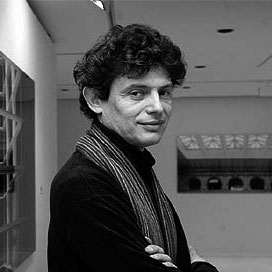Ballester in these years, has been interested in a great diversity of subjects: he has captured in his images different landscapes of the world, has dissected industrial buildings, and has stopped to observe the spatial architecture of museums that have been renovated, closed or even they disappeared, but among all the images collected in this exhibition, one may surprise one: the monumental photograph (eight meters) that reproduces the room that Leonardo da Vinci painted in his masterpiece "The Last Supper". Ballester suppresses in his photograph the apostles of the original mural painting, leaving the gaze of the spectator to walk the table naked with the remains of the recent Supper. "There are thousands of occasions when human presence comes out of the scene, those empty spaces are full of information," says the artist.
He does the same with works by other great painters of the Italian Renaissance such as Fra Angelico or Giotto, works that he outlines, leaving the spaces represented but eliminating human presence from all of them: "This is due to my predilection to choose those moments when the direct presence fades or disappears "
In the words of the curators María de Corral and Lorena Martínez de Corral, "the images of Ballester are enigmatic and beautiful, open and impenetrable", as shown by the tour of this exhibition that highlights the personal treatment of the image that Ballester makes Through the three key elements of his work: time, light and space. Two photographs of the Tabacalera building (in which the exhibition is exhibited) also highlight the uniqueness of this space as a continent and content of this exhibition, organized and produced by the General Subdirectorate for the Promotion of Fine Arts of the Ministry of Education, Culture and Sport and that has had the collaboration of Acción Cultural Española (AC / E).
Interview | José Manuel Ballester.
In this exhibition, where we can once again enjoy the mastery of your frames, clean and cared for in symmetry and composition, how do you think Tabacalera's space acts as a container of that purity of lines, of those "Forests of Light"? ? Does the particularity of this space add, highlight or praise any ingredient to the work you now present to us? It has been tried to take advantage of the potential of the place to present this show and thanks to the great help of the curators María and Lorena de Corral and their vision of my work, I think it has been achieved. I hope that there is a counterpoint in what refers to the most minimalist photographs and that those that have an affinity with the place are very well integrated. Between them there will be two images of Tabacalera's own space.
There are very different themes in the exhibition that you present, from the Hidden Spaces of Italian Renaissance painting, to industrial warehouses as the key to time. What led you to investigate at both ends? The themes that I have attended the most in recent years appear: urban landscapes, industrial themes, the series of hidden spaces and finally natural landscapes that in a certain way, revive my first neo-romantic landscapes painted in the eighties and that emerge in a photographic key . I believe that my photographic work is enriched by painting, an activity that I continue to carry out and that is, in some way, very present in this exhibition.
Complete interview here
Place.- Tobacco store | Space Promotion of Art | C / Embajadores, 51. 28012 Madrid.
Dates.- 7 FEBRUARY | 28 APRIL | 2013. Open to the public from Tuesday to Friday: from 12'00 to 20'00h. Saturdays, Sundays and holidays: from 11'00 to 20'00h. Closed Monday. Free admission.
CREDITS.
Commissioners.- María de Corral / Lorena Martínez de Corral.
Coordination.- Mariflor Sanz.
Photocopies.- Raúl Carreño / Clorofila Digital / Hal 9000 S.r.l.
Assembly Address.- María de Corral / Lorena Martínez de Corral.
Graphic Design and Technical Assembly.- N2.Graphic Study.
Assembly.- Artec Exposiciones, S.L.





























